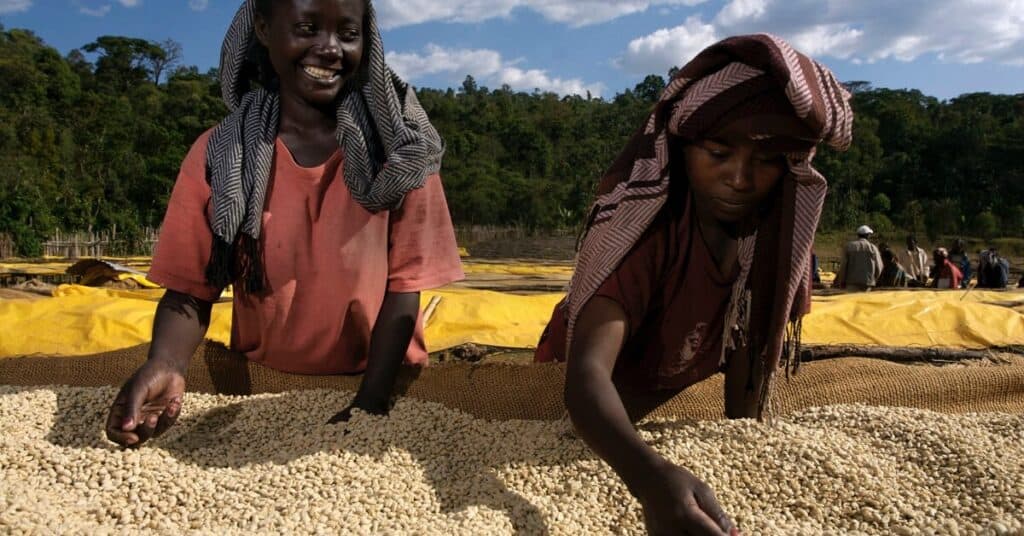
Ethiopia is considered the cradle of coffee – something that can give a lot of expectations. But can the East African country live up to those expectations? Before we get that far, let’s just take a trip down the road of history and how Ethiopia has become the great coffee country it is today considered.
Ethiopian coffee – then and now
Ethiopia is considered the homeland of coffee, and there is a good little story attached to it. It is about a shepherd who was guarding his sheep in 17th century Ethiopia. At one point he sees his sheep eating some berries on the plains, after which they begin to behave very especially – they become full of energy!
Curious about what happened, the shepherd himself eats some of the berries and gets himself a lot of energy. He picks a lot of berries and takes them home to family, friends and acquaintances. They also like the effect of the berries.
This is reportedly the beginning of the glorious history of coffee – on the Ethiopian plains where the coffee berries grew wild and were originally used as food rather than drink.
What is factual or wandering history is not known, but it should be correct that the first coffee plants sprouted wild in Ethiopia and the prayer only later became something that was used for the drink we know today.
As interest in this exciting new discovery developed, and it was discovered that one could use the stone of the berry for coffee, a demand gradually began to occur – also from abroad. Traders from Europe began to take the beans home, and successfully drove them back to Ethiopia for more.

During the 19th century, coffee production became somewhat more structured. It culminated in a state coffee association (National Coffee Board of Ethiopia) in 1957. This was to promote this delicate and in-demand product.
Coffee production in Ethiopia has historically always been characterized by irregularities – both in terms of quantity and quality – due to internal unrest in the country with civil wars, dictatorship and the struggle for democracy. All of which have had an impact on the production apparatus.
Fortunately, in recent times there has been calmer in the countryside, and they persist to this day as a country that ranks high on the rankings of the best coffee-producing countries – in general.
Buy Ethiopian coffee if you are into filter coffee
Ethiopian coffee certainly belongs at the high end of the quality scale. Ethiopian coffee is generally very fruity and sour in taste – not least the naturally processed beans, which are dried with the pulp on rather than rinsed off.
Ethiopian coffee is best suited for filter coffee. If you buy or roast coffee for espresso, it is typically significantly darker than for a filter. This shakes off many of the good fruity and sour shades. The coffee instead becomes sweeter and “heavy”.
It’s a bit of a shame to toast away the fruit notes that are exactly characteristic of Ethiopian coffees.
It is therefore a really good idea to use Ethiopian coffee as filter coffee – be it Hario V60, Aeropress, Chemex or “just” a good, old-fashioned machine coffee.
Areas / farms
Although Ethiopia boasts a great international reputation for coffee, it does not actually have as many growing areas as Brazil. In return, they maintain a higher standard – not least from the following areas:
Sidamo
Coffee from here has a high reputation, i.a. for its naturally processed beans that provide a very fruity and aromatic cup of coffee. It is an approx. 50/50 ratio of naturally processed and washed beans in the region. The coffee is grown from October to January at altitudes between 1400 m and 2200 m.
Harrar
One of the oldest coffee regions in the country, which has a reputation for being very diverse in its coffee production. Not so much the methods as the final product that can be described as everything from impure and woody to nicely fruity with blueberry notes. The cultivation takes place from October to February and is grown at altitudes of 1500-2100 m.
Yirgacheffe
Another one of the most famous and popular coffee regions in the world. Particularly recognized for high but round/soft aroma, fruitiness and citrus-like acidity. Someone compares it to tea because of the flavour nuances. The Yirgacheffe region offers both washed and naturally processed beans grown from October to January at 1750-2200 m altitude.
Ethiopian coffee for the fruity
Ethiopian coffee is definitely recommended – especially if you are into filter coffee and love exciting, fruity notes in your coffee. Here, Ethiopia is truly a strong coffee country, and it is a country with an exciting and traditional coffee history.



Comments are closed.